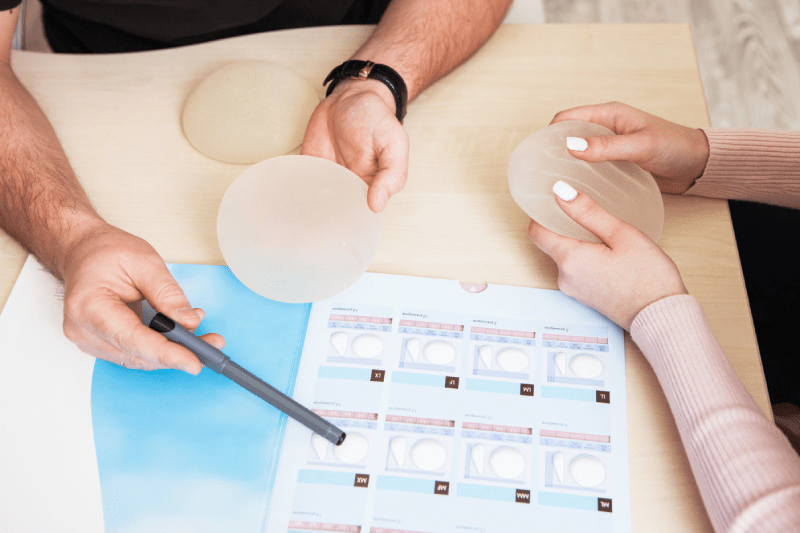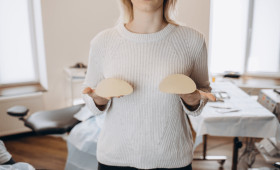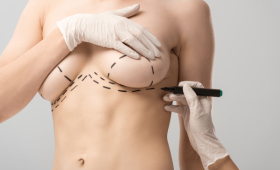Why Is Kusadasi Preferred For Breast Enlargement Surgeries?
Kusadasi stands out as a destination in the Aegean and Mediterranean regions because it combines the potential of health tourism with high-standard aesthetic surgery services. Hospitals and centers in the region possess international accreditations and provide services with experienced surgeons and modern technological equipment.
One of the biggest factors attracting patients from abroad is the offering of much more affordable costs compared to operations of similar quality in Europe or America. Patients have the opportunity to spend their post-operative recovery periods accompanied by the comfort and relaxing atmosphere of a peaceful coastal town; this makes Kusadasi an ideal center for aesthetic tourism.
What Exactly Is The Breast Enlargement Surgery Procedure?
Breast enlargement surgery (Augmentation Mammaplasty) is the procedure of placing silicone gel or saline (salt water) implants under the breast tissue or under the chest muscle to increase the size and fullness of the breasts. The main purpose of the operation is to create a breast silhouette that is proportional, natural-looking, and harmonious with the body contours. The surgeon considers the patient’s current breast structure, skin elasticity, and personal expectations to decide on the implant’s shape, size, and placement plane. This detailed planning is the key to achieving a successful and aesthetically satisfying result.
How Do I Know If I Am A Suitable Candidate For Breast Enlargement?
The first condition for being a suitable candidate for breast enlargement surgery is being over 18 years old and having completed breast development. The candidate must be in good general health, have no chronic illnesses (such as uncontrolled diabetes), and have no condition preventing them from undergoing anesthesia. Aesthetically, women who are dissatisfied with the size of their breasts, have asymmetry between breast sizes, or have lost volume after pregnancy/weight loss are suitable candidates. Most importantly, the patient must have realistic expectations about the surgical outcomes and possess the psychological readiness to adhere to the recovery process.
What Types Of Implants Are Used During The Operation?
Implants used in breast enlargement operations are fundamentally divided into two main categories: silicone gel implants and saline (salt water) implants. Silicone gel implants are the most preferred type today because they provide a more natural tissue feel and have a lower risk of leakage if ruptured. Implants are also categorized by shape into round or anatomic (teardrop). Teardrop implants provide more fullness to the lower part of the breast, ensuring a more natural curve, while round implants are generally preferred to give a fuller appearance to the upper part of the breast.
What Does The Best Price Guarantee Mean In Kusadasi?
The “Best Price Guarantee” offered in Kusadasi generally means combining high-quality medical services with a competitive pricing policy. This guarantee provides assurance that the service the patient will receive (such as surgery, implant brand, hospital accommodation, transfers) is offered at a more favorable price than another quote of the same quality and scope. Thanks to the low general operating costs and exchange rate advantage in Turkey, centers in Kusadasi can offer the same standard of surgery, performed with equivalent internationally recognized implant brands used in Western countries, much more economically. This guarantee is a commitment to help the patient both protect their budget and not compromise on quality.
What Factors Are Considered When Choosing Implant Size?
Multiple critical factors are considered when selecting the implant size. The most important factors are the patient’s chest width, the volume of existing breast tissue, the elasticity of the skin and sub-mammary tissue, and the patient’s height/weight ratio and overall body proportions. After listening to the patient’s expectations, the surgeon determines the most appropriate volume (in cc) using various measurement techniques and 3D simulation devices. Choosing an implant that is too large can lead to problems like excessive tension and sagging of the breast tissue in the long term, while choosing one that is too small may not meet the patient’s aesthetic expectations. The correct size is the one that will yield the best result, both aesthetically and functionally.
What Preparation Process Is Required Before Surgery?
Before breast enlargement surgery, a meticulous preparation period is essential for the process to proceed successfully and safely. Patients must completely stop smoking and alcohol consumption at least two weeks before the operation, as these negatively affect blood circulation and wound healing. Blood-thinning medications, herbal supplements, and certain vitamins must also be discontinued under doctor’s supervision. Before the surgery, blood tests and generally a mammogram or breast ultrasound may be requested to check the general health status. Finally, it is important that patients wear comfortable, front-buttoned or zippered clothing on the day of the operation and fast (at least 8 hours).
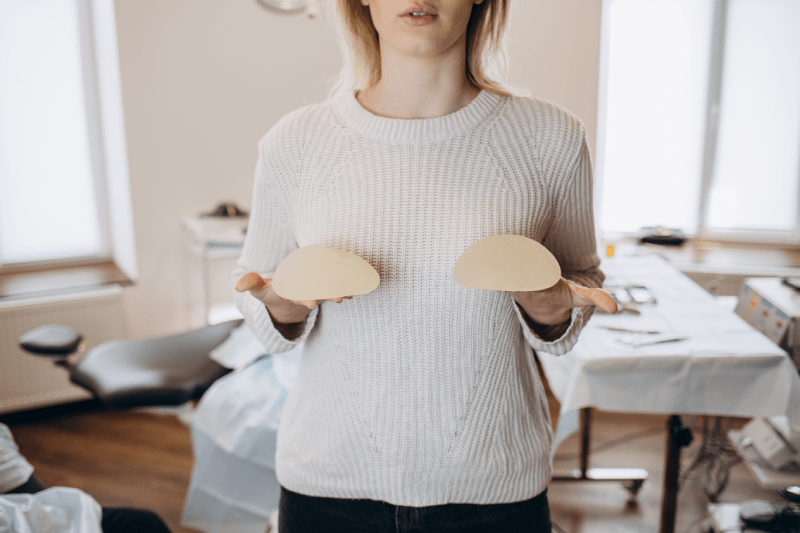
How Is Pain Management Provided After Surgery?
Breast enlargement surgery can cause some pain, especially when implants are placed under the muscle, but modern hospitals in Kusadasi place great importance on pain management. During the surgery, long-acting local anesthetics are applied to the incision areas by the surgeons, greatly reducing the initial sensation of pain. During the hospital stay (usually 1 night), powerful intravenous painkillers are regularly administered by nurses. After discharge, the patient is prescribed effective oral painkillers. Thanks to this regular medication use and ice application, the vast majority of patients complete the recovery process comfortably.
Where Do The Surgical Scars Remain And What Is Their Visibility?
Scars are inevitable in breast enlargement surgeries, but they are strategically concealed in the least visible places by experienced surgeons. The most common incision sites are: the fold under the breast (inframammary), around the nipple (periareolar), or the armpit. The inframammary fold incision is generally easily concealed with underwear or a bikini and has the potential to leave the thinnest scar during the healing process. The armpit incision leaves no scar on the breast but is a more complex technique. Scars may initially be red and prominent, but they generally fade to near skin-color within one year.
Are Breast Implants Placed Under The Muscle Or Under The Breast Tissue?
The plane where the implant is placed depends on the amount of the patient’s existing breast tissue and the surgeon’s preference. Placement under the breast tissue (subglandular) can accelerate healing and shorten the operation time, but it can make the edges of the implant more visible from the outside in patients with thin breast tissue. Placement under the chest muscle (submuscular) provides a more natural appearance by covering the implant with more tissue and reduces the risk of capsular contracture. The decision on which plane to choose is made after the surgeon evaluates the anatomical structure of the breast and the patient’s expectations during the initial consultation.
Is There A Risk Of Implants Being Rejected By The Body?
The risk of breast implants being “rejected” by the body (biological incompatibility) is quite low thanks to the high biocompatibility of modern medical silicone and saline implants. The body may perceive the implants as a foreign object, but it usually reacts by forming a hard scar tissue called capsular contracture around the implant rather than “rejection.” To reduce the risk of capsular contracture, it is important to place the implants under the muscle, perform massage, and adhere to the surgeon’s instructions. The high quality and international certifications, such as FDA approval, of the implants used minimize such risks.
What Is Capsular Contracture And How Is It Treated?
Capsular contracture is the excessive thickening and hardening of the scar tissue (capsule) that surrounds the breast implant over time. This condition can lead to hardness, pain, and distortion of the breast shape. Contracture can occur in mild (not noticeable) or severe (where the breast hardens and causes pain) degrees. Treatment varies depending on the severity of the condition. While massage may be recommended for mild cases, in severe cases, a surgical procedure called capsulectomy is performed to remove the hardened tissue around the implant, and the implant is usually replaced with a new one. The risk of capsular contracture can be reduced with correct surgical technique and post-operative care.
What Is The Length Of Hospital Stay After Surgery?
Although breast enlargement surgery is generally a major surgical procedure, in clinics in Kusadasi, considering patient comfort and safety, it is often performed with a 1-night hospital stay. The day after the operation, the patient is discharged after the first check-up and dressing by the surgeon. This one-night stay is important for the patient to fully recover from the effects of anesthesia, for pain management to be adjusted, and for close monitoring of possible early complications (such as bleeding). After discharge, patients continue to rest at their accommodation in Kusadasi.
How Long Should The Total Stay In Kusadasi Be?
The stay for international patients undergoing breast enlargement surgery in Kusadasi is generally planned for a ** total of 7 to 10 days** for safe travel and initial recovery. During this period, the patient undergoes the surgery (Day 1), stays in the hospital (1 night), then rests at their accommodation, and is under the follow-up of the surgical team. Critical steps such as control appointments, dressing changes, and the removal of stitches (if any) are completed around the 5th and 7th days after surgery. After receiving travel approval from the surgeon at the end of the 7th or 10th day, the patient can safely return to their country.
When Does The Breast Tissue Soften After Surgery?
The softening of the breast tissue and the attainment of the final shape after surgery take time, depending on the plane of implant placement and the patient’s healing rate. Initially, the breasts may feel swollen and firm. This firmness can be more pronounced, especially if the implants are placed under the muscle. The softening of the breasts usually accelerates after the second month. Full softening and the implants “settling” generally take 3 to 6 months. Regular application of massage techniques recommended by the surgeon during this period can support and accelerate the softening process.
Are Swelling And Bruising Normal After The Operation?
Yes, swelling (edema) and bruising in the breasts and chest after breast enlargement surgery are completely normal and are a natural part of the healing process. Swelling generally peaks within 3 to 5 days following the operation. Bruising may be dark in color in the first few days but turns yellow within a few days and generally disappears within two weeks. To reduce swelling, patients are advised to apply cold compresses in the first few days and continuously use the surgical bra. Although most of the swelling subsides within the first month, the complete dissipation of slight edema may take a few months.
When Can I Start Using A Normal Bra?
Initially after the surgery, the special surgical or sports bra provided by the surgeon must be used. This bra helps the implants stay in the correct position, reduces swelling, and provides necessary support to the breast tissue. The use of the surgical bra is mandatory, usually for the first 4 to 6 weeks, day and night (except when bathing). The transition to normal, underwire, or supportive bras can only be made gradually after the 6th week with the surgeon’s approval. Using underwire bras too early can put pressure on the healing tissues and increase the risk of capsular contracture.
When Can I Start Exercising Or Playing Sports?
After breast enlargement surgery, exercise should be resumed gradually and cautiously. For the first 2 weeks, only non-strenuous activities like light walking should be performed. Cardio exercises that strain the breast incision lines or require excessive arm movements (running, stretching) can generally be started after 3 to 4 weeks. Intense activities like heavy lifting, push-ups, or chest exercises that strain the chest muscles should be postponed for at least 6 to 8 weeks. Adhering to these rules is crucial to prevent the stitches from opening and the implant from shifting.
Do Implants Increase The Risk Of Breast Cancer?
Current scientific research and long-term clinical studies indicate that there is no definitive evidence that silicone or saline breast implants increase the risk of breast cancer. However, implants can make the imaging of breast tissue (mammography) slightly more difficult. Therefore, patients with implants must undergo imaging using special techniques by technicians and radiologists experienced in mammography for augmented breasts. Furthermore, women with implants should continue to perform regular self-examinations and not neglect annual check-ups.
Do Implants Hinder Breastfeeding?
When the correct incision and placement technique are applied, breast enlargement surgery generally does not cause permanent damage to the ability to breastfeed. The main factor that could affect breastfeeding ability is the risk of damage to the milk ducts and nerves in incisions made around the nipple (periareolar). The inframammary fold and armpit incision techniques are considered safer for breastfeeding, as they involve minimal intervention to the milk ducts. Additionally, placing the implants under the muscle rather than under the breast tissue also helps protect the breastfeeding function by reducing pressure on the milk glands.
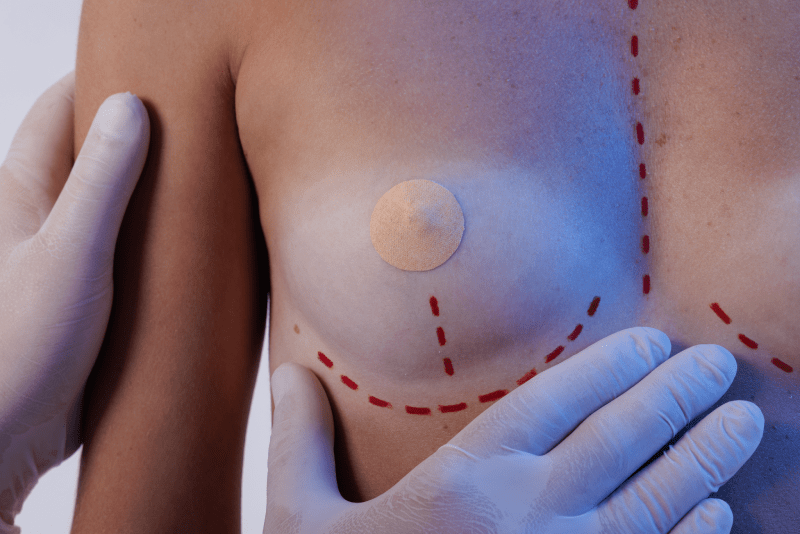
Will There Be Numbness In The Nipple After Surgery?
It is quite common to experience temporary loss of sensation, numbness, or excessive sensitivity in the nipple after breast enlargement surgery. This is related to the temporary impact on the nerves that supply and provide sensation to the nipple during the surgical procedure. Generally, these sensation changes gradually resolve in the weeks or months following the surgery. Although sensation returns to normal levels in the majority of patients, rarely, some patients may experience permanent changes in the form of decreased or increased sensitivity. Surgeons take care to use the most delicate techniques to protect the nerves.
Does The Best Price Guarantee Affect Implant Quality?
The “Best Price Guarantee” service in Kusadasi does not mean that implant quality is compromised. On the contrary, this guarantee is usually offered in conjunction with the use of high-quality implant brands (such as European and American origin) that are internationally accepted, FDA-approved, and have a long-term longevity guarantee. The price advantage is provided through the bulk purchasing power of implants, and the lower labor and general operating costs in Turkey. Health tourism centers must keep costs down to compete while maintaining the highest level of patient safety and implant quality.
Is There An Age Limit Or Weight Requirement For The Surgery?
The minimum age limit for breast enlargement surgery is at least 18 years old, considered the age when breast development is complete. There is no upper age limit as long as the patient’s general health status is suitable for anesthesia and she can comfortably get through the recovery process. The weight requirement suggests that patients’ Body Mass Index (BMI) should be within healthy limits (preferably below 30) and they should be close to their ideal weight. If the patient plans significant weight loss after the surgery, performing the operation after this process is complete will be more appropriate for the long-term aesthetic results.
How Often Are Post-Surgery Check-Ups Done?
The initial follow-up period after breast enlargement surgery is very important for a successful outcome. Patients are checked by the surgeon several times (usually 2-3 appointments) during their stay in Kusadasi (7-10 days) for dressing changes, drain follow-up, and stitch removal. After returning home, patients are kept in contact with the surgical center, and their recovery process is monitored through tele-consultations. In the long term, patients are advised to see their surgeon once a year to check the status of the implants and have imaging tests (MRI/ultrasound) performed at certain intervals (e.g., every 5-10 years).
Can Implants Rupture Or Leak?
Modern silicone gel implants contain a much more durable and cohesive (shape-retaining) gel than previous generations, so the risk of spontaneous rupture is extremely low. Theoretically, there might be a risk of rupture in cases of severe trauma, such as a traffic accident. Even if rupture or leakage occurs, the cohesive gel does not spread into the breast. Implants can wear out over time, or small tears may occur on their outer surface. In such cases, they usually show no symptoms and are detected with routine imaging (MRI). If implant leakage is detected, the implant needs to be replaced with a surgical procedure.
Is There A Translator Service For Patients From Abroad?
Aesthetic centers focused on health tourism in Kusadasi offer professional translation services as a standard for the comfort and safety of international patients. Translators accompany the patient throughout the entire process, from airport pickup to initial consultations, meetings with the anesthesiologist, and communication of post-operative instructions. This service ensures the patient receives accurate and complete information about surgical procedures, risks, and care instructions in their native language, completely eliminating communication barriers.
When Can I Start Driving After Surgery?
The time to start driving after breast enlargement surgery depends on the type of incision and the plane of implant placement. However, it is generally recommended to avoid driving for at least 2 weeks. In patients with submuscular placement, arm movements such as turning the steering wheel and sudden braking can strain the chest muscles, causing severe pain and stressing the stitches. It is mandatory for patients to no longer be using painkillers and to be able to move their shoulders comfortably before starting to drive.
What Sleeping Position Should Be Preferred After Surgery?
For the first 3 to 4 weeks after the surgery, patients must absolutely sleep on their back. Lying on the side or stomach can put pressure on the newly placed implants, potentially distorting their shape and even causing them to shift. When sleeping on the back, slightly elevating the head and torso (with the help of several pillows) can help reduce swelling and provide a more comfortable sleeping position. Transitioning to side or stomach sleeping should not be done without the surgeon’s approval.
When Will I Start Seeing The Permanent Results Of The Surgery?
To fully see the final and permanent results of the breast enlargement surgery, it is necessary to wait at least 6 months to 1 year. In the first months, the breasts may appear swollen, high, and firm. After the 3rd month, the shape of the breasts gradually begins to settle, swelling subsides, and the implants gain a natural appearance due to the effect of gravity. The softening of the breasts, the complete maturation of the scars, and the skin’s adaptation to the new shape of the implant are generally completed by the end of the 12th month. Patience and adherence to the surgeon’s instructions are the most important factors in this process.
Are Hardness Or Tissue Hardening Around The Implant Normal?
In the first weeks of the post-operative recovery period, it is normal to feel temporary hardness, tightness, or tissue hardening around the implant and along the incision line. This is caused by tissue trauma, fluid accumulation (edema), and the body’s natural process of forming a capsule (membrane) around the implant. Most of this hardness usually softens and disappears within a few months. Regular application of massage techniques recommended by the surgeon can help resolve these hard areas. However, if the hardness increases, is accompanied by pain, or the breast shape is distorted, it should be immediately discussed with the surgeon, as it could be a sign of capsular contracture.

What Type Of Anesthesia Is Used During The Operation?
Considering patient comfort and the duration of the operation, breast enlargement surgery is usually performed under general anesthesia. General anesthesia ensures that the patient is completely asleep throughout the operation and does not feel any pain or awareness. In modern hospitals in Kusadasi, this process is managed by an experienced anesthesiologist, and the patient’s vital functions are continuously monitored. General anesthesia allows the surgeon to perform the procedure with high precision and is the safest and most comfortable option for the patient.
Is A Mammogram Or Ultrasound Necessary Before Surgery?
Yes, it is a common and necessary practice to request a mammogram or breast ultrasound before surgery, especially from patients aged 40 and over or younger patients with a risk of breast cancer, to check breast health. These imaging tests enable the detection of any existing masses, cysts, or suspicious formations in the breast tissue before implant placement. The assessment of breast health is critically important for safe planning of the operation and long-term patient follow-up. The surgeon decides on the feasibility of the operation based on the results of these tests.
When Can I Start Sleeping On My Stomach After Surgery?
Returning to sleeping on the stomach after breast enlargement surgery requires waiting at least 6 weeks. The supine (on the back) sleeping position is mandatory for the first few weeks to ensure the implants stay in place and to prevent pressure on the incision lines. At the end of the 6-week period, side sleeping can be gradually resumed with the surgeon’s approval. Sleeping on the stomach, which can put pressure on the breasts, is generally attempted after a longer period, at least 2-3 months later, once the breasts have fully healed and the implants have fully settled. The surgeon’s advice should always be the priority in this matter.
What Style Of Clothing Should Be Preferred During Recovery?
For patient comfort and protection of the incision lines during the recovery period, loose-fitting, soft, and front-buttoned or zippered clothing should be preferred. Since lifting the arms and wearing clothes that tie at the back will be difficult immediately after the surgery, front-opening clothes offer great ease. Cotton or soft fabrics that will not press against the surgical bra or cause friction are ideal. For the first 4-6 weeks, tight, restrictive clothing and underwire bras must be strictly avoided. Clothing should support and not restrict the healing process.
What Services Are Included In Kusadasi Packages?
Health tourism centers in Kusadasi stand out for the comprehensive packages they offer to international patients. These packages generally include: the surgical fee, implant costs (depending on the chosen brand), anesthesia and hospital costs (operating room and 1 night stay), the first post-operative surgical bra and medications, airport and local transfers, and 7 to 10 days of hotel accommodation. Furthermore, necessary pre-operative blood tests, radiological examinations, and post-operative follow-up checks are also generally an integral part of this package. This “all-inclusive” approach ensures cost transparency.
Do Stretch Marks Form On The Skin After Surgery?
The risk of stretch mark (striae) formation on the skin after breast enlargement surgery, due to the rapid increase in breast volume, exists, especially in patients whose skin is not sufficiently elastic and who choose very large implants. To prevent stretch mark formation, surgeons evaluate the patient’s skin elasticity and select an appropriate implant size. Plenty of water consumption, moisturizing creams, and massage applications are important to increase skin elasticity before and after the surgery. To minimize the risk of stretch marks, the implant size should be compatible with the body anatomy, aiming for a natural proportion.
What Should Be Done For Scars That Form After Surgery?
Regular and correct care is essential for scars to heal and become as minimally visible as possible after surgery. Scars may be red and raised for the first few months. Surgeons generally recommend using silicone-based scar gels, tapes, or creams after the stitches are removed and the wound has closed. These products help the scars fade faster by keeping the incision moist and regulating collagen production. Furthermore, it is crucial to absolutely protect the scars from the sun during the first year of healing; otherwise, the scars can darken and become permanent. Regular massage also contributes to the softening of the scar tissue.
Do Pregnancy Or Weight Changes Affect The Results?
Yes, significant weight changes or pregnancy after breast enlargement surgery can negatively affect the aesthetic results achieved. Pregnancy and breastfeeding can lead to renewed growth, volume loss, and sagging in the breast tissue. Significant weight gain or loss can affect skin elasticity, causing changes in the shape and position of the breasts. Therefore, surgeons advise patients to reach their ideal weight before the surgery and avoid large weight fluctuations after the operation. If the results are compromised, a breast revision operation may be necessary in the future.
What Are The Possible Risks Of Breast Enlargement Surgery?
Although breast enlargement surgery is generally a safe procedure, like any surgical procedure, it carries some risks. Possible risks include infection, bleeding, wound healing problems, capsular contracture, implant displacement, asymmetry in breast shape, and changes in nipple sensation. The surgeon’s experience, the hospital’s hygiene standards, and the patient’s diligent adherence to post-operative instructions largely mitigate these risks. Complications are rare, but it is important for the patient to be fully informed about these risks before the operation and make a conscious decision.
What Is The Importance Of The Special Bra After Surgery?
The special surgical bra or sports bra used after surgery plays a critical role in the success of the recovery process. This bra applies gentle and constant pressure to the operated area, reducing swelling (edema) and bruising. Most importantly, it helps the implants stay in the correct position during the initial healing period and provides support to the incision line under the breasts. The purpose of the bra is to help the breasts adapt to their new shape and minimize the risk of implant displacement. According to the surgeon’s instructions, it must be worn continuously day and night for the first few weeks.
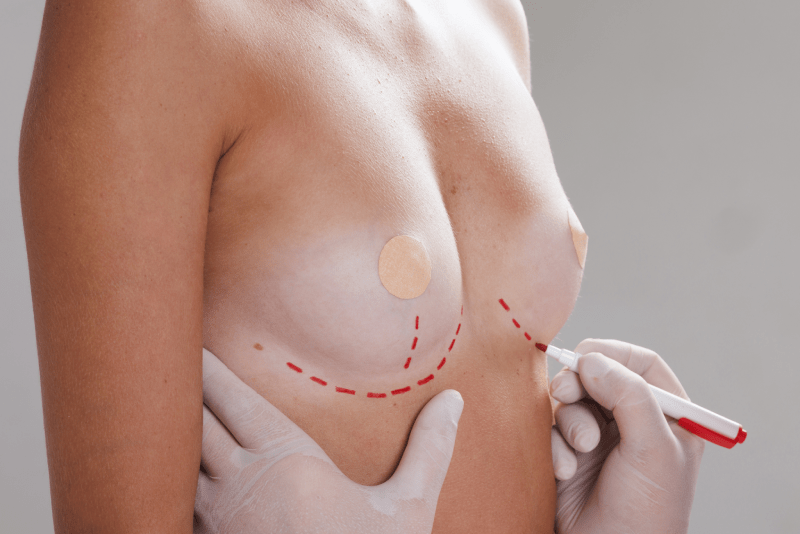
What Is The Lifespan Of Implants And Do They Need Replacement?
Modern silicone gel breast implants are much more durable than previous generations, and most manufacturers offer a lifetime warranty. Despite this guarantee, the implants’ time in the body is not indefinite, and they have a lifespan. Implants can wear out over time, or rarely, capsular contracture may develop. Therefore, it may be necessary to check the condition of the implants and replace them (revision) upon the surgeon’s recommendation, generally every 10 to 15 years. Regular annual check-ups and imaging tests (MRI/ultrasound) should be performed to closely monitor the implant status.
What Tests Are Required Before The Operation?
Various medical tests are mandatory before breast enlargement surgery to evaluate the patient’s surgical suitability and general health status. These generally include complete blood count, bleeding and clotting time, screening for infectious diseases (Hepatitis B, C, HIV), and biochemistry tests. Additionally, an EKG (electrocardiogram) and chest X-ray may be requested to ensure anesthesia safety. These analyses are vital for pre-determining potential risks (bleeding disorders, infections) and taking necessary precautions for the operation to proceed safely.
What Is Included And Excluded In The Treatment Package?
Aesthetic treatment packages in Kusadasi generally include comprehensive services. Inclusions typically are: the surgical fee, implant costs (depending on the chosen brand), hospital costs (operating room and 1-night stay), anesthesia, medications, and surgical bra, airport and local transfers, and 7-10 days of accommodation. Exclusions are the additional treatment costs for complications (rarely encountered), international flight tickets, and personal expenses. Under the “Best Price Guarantee,” it is important that all details of the package offered to the patient are transparently specified.
What Kind Of Nutrition Should Be Followed In The First Days?
In the first days after the surgery, light, liquid, and easily digestible foods should be preferred due to the effects of anesthesia and the risk of nausea. Hot beverages should be avoided, and plenty of water and protein-rich liquids (bone broth, protein shake) should be consumed. To support the healing process, the consumption of foods high in protein, Vitamin C, and zinc is important. Avoiding salt and processed foods helps reduce swelling. After the first few days, the patient can gradually return to a normal, healthy diet.
What Medications Or Supplements Should Be Stopped Before Surgery?
All medications and supplements that may increase the risk of bleeding must be stopped under doctor supervision before the surgery. The most important of these are non-steroidal anti-inflammatory drugs (NSAIDs) such as aspirin and ibuprofen and prescription blood thinners. Additionally, herbal supplements like Vitamin E, fish oil, ginseng, and ginkgo biloba should also be discontinued at least 7 to 14 days before the surgery, as they have the potential to thin the blood. The complete history of all medications and supplements must be reported to the surgeon and anesthesiologist before the operation.
Can Breast Implants Be Removed Or Replaced In The Future?
Yes, breast implants can be removed or replaced with new ones (revision surgery) in the future, based on the patient’s request or medical necessities (capsular contracture, rupture, shape change). Implant removal may cause the breasts to return to their former state or sag, which is why a breast lift (mastopexy) operation is often combined with the removal procedure. Revision surgery can be more complex than the initial operation and requires the surgeon’s experience. The decision to remove or replace the implants must be made after a detailed evaluation by the surgeon and the patient.
These 46 detailed questions and answers provide a comprehensive guide to breast enlargement surgery in Kusadasi. To receive the highest quality service at the most suitable prices, in a comfortable holiday environment, and to plan your entire operation process safely, we recommend contacting Cure Holiday with our expertise in health tourism. We would be happy to support you in achieving the aesthetic look you dream of.
